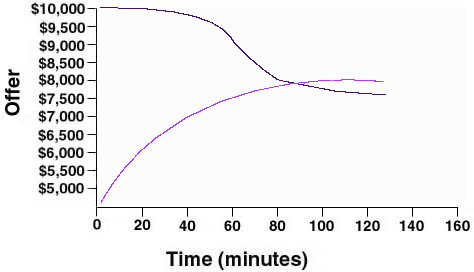
◙◙◙◙◙◙◙◙◙◙◙◙◙◙◙◙◙◙◙◙◙◙◙◙◙◙◙◙◙◙◙◙◙◙◙◙◙◙◙◙◙◙◙◙◙◙◙◙◙◙◙◙◙◙◙◙◙◙◙◙◙◙◙◙◙◙◙◙◙◙◙◙◙◙◙◙◙◙◙◙◙◙◙◙◙◙◙◙◙◙◙◙◙◙◙◙◙◙◙◙◙◙◙◙◙◙◙◙◙◙◙◙◙◙◙◙◙◙◙◙◙◙◙
The conclusion of negotiation
Mismatching occurs at the end of the negotiations as the parties try to conclude an
agreement. It is not uncommon for one side that has been making regular
concessions to stop making concessions just before a deadline, knowing that the
other side will feel the same deadline pressure and might make large
concessions. That would be an example of mismatching.
Of course, sometimes matching does occur as each side makes very small concessions as he or she jockeys to get the best possible deal. Sometimes matching involves very large concessions as each side feels the pressure of an impending deadline and wants to make the concessions they feel they need to in order to reach an agreement before the deadline.
Even something that appears to be matching may really not be that. Suppose that near the end of negotiations one party says, "we're not that far apart -- let's just 'split the difference,' OK?" Perhaps the speaker would already receive favorable outcomes if he simply accepted the latest offer from the other party. He has already negotiated a favorable deal and is simply "nibbling" for a slightly better deal.
Notice that the "Mismatching - Matching - Mismatching" sequence may occur if one
side is using the "S" -shaped concession curve described earlier.

Here the dealer is making small concessions early while the buyer is
making larger ones during the first 40 minutes.
Then the two sides are Matching – both are making moderate-sized concessions between
the 40 minute and 80 minute marks.
Finally, the parties are Mismatching – the dealer is "holding out" for a
favorable deal by asking the buyer to make that last concessions, which the buyer does.
What are the tactical implications of the Mismatching – Matching – Mismatching phenomenon?
According to Professors Dean Pruitt & Peter Carnevale,
two negotiation scholars, it is better to start with an extreme initial offer,
make small concessions early, and then make fairly regular concessions
throughout the middle phase of negotiations IF the other also makes
concessions. Then, if you are willing to take the risk that you can do so without
alienating the other side, make small concessions and hope that the other side will fill
the gap. They suggest that this is a better approach than making a generous initial offer
and making very few additional concessions.
| Review Question: | ||
|---|---|---|
| The most common sequence is which of the following? | ||
|
|
Matching - Matching - Mismatching. | |
|
|
Mismatching - Matching - Mismatching. | |
|
|
Mismatching - Matching - Matching. | |
|
|
Matching - Mismatching - Mismatching. | |
|
|
Mismatching - Mismatching - Matching. | |
There are a variety of combinations of concession curves.
The purpose of this tutorial is not to teach you an exhaustive list.
Rather, it is to help you:
-become familiar with the concept of concession curves.
-recognize typical "common" patterns of concession curves.
-help you use these ideas to secure a favorable agreement to your side without irritating
the other side so much that they break off the negotiations.
◙◙◙◙◙◙◙◙◙◙◙◙◙◙◙◙◙◙◙◙◙◙◙◙◙◙◙◙◙◙◙◙◙◙◙◙◙◙◙◙◙◙◙◙◙◙◙◙◙◙◙◙◙◙◙◙◙◙◙◙◙◙◙◙◙◙◙◙◙◙◙◙◙◙◙◙◙◙◙◙◙◙◙◙◙◙◙◙◙◙◙◙◙◙◙◙◙◙◙◙◙◙◙◙◙◙◙◙◙◙◙◙◙◙◙◙◙◙◙◙◙◙◙